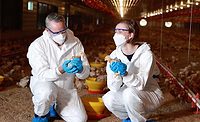The safety of our food supply chain is critical to the health of all consumers and the viability of businesses dealing with food. Unsafe food causes more than 200 illnesses, ranging from diarrhea to cancers. According to the World Health Organization, a shocking 600 million people fall ill annually from consuming unsafe food, and 420,000 die every year.1
Once seen as a cost burden and the responsibility of technical and production functions, food safety has become a company-wide, end-to-end business priority. Every role within the supply chain, from quality assurance to transport and logistics, to warehouse and sales, has an essential role to play in ensuring food safety. By working together, businesses can continue to raise capabilities and support those with limited resources to ensure that we safely pass the parcel.
Food safety has always been an important issue, but like workplace health and safety, its profile is growing and must be viewed as a business essential.
Economic Impact
Ensuring food safety has become increasingly complex, with new consumer-ready products being sold in international markets, advanced production technologies, lengthy supply chains, the rising variety of ingredients and suppliers, and the growing potential for malicious behavior.
John Watling, Professor of Forensic and Analytical Chemistry at the University of Western Australia, estimates that every fifth product Australian consumers buy during an average shopping trip could be mislabeled or adulterated, with olive oil, fish, and organic products among the most common foods subject to fraud.
Food fraud—fake, cheap, and often dangerously low-quality products sold under the label of well-known brands—costs the Australian economy an estimated $2–3 billion each year2 and the global food industry an estimated $50 billion or more each year.3
The increasing number of variables (including the impacts of climate change) that disrupt existing food safety controls require ongoing vigilance across each person and every part of the supply chain.
Leveraging Consumer Interest to Reduce Food Fraud
The rising consumer interest in food security, traceability, and provenance, and new technologies such as blockchain and the Internet of Things, provide opportunities for businesses to implement new ways of reducing food fraud.
Australia has an excellent international reputation for producing premium, safe, and high-quality products. Its close proximity to Asian markets and reputation as a trusted exporter of premium goods has helped the food and beverage sector become the largest manufacturing sector for the Australian economy.4
According to Food Innovation Australia Limited (FIAL),2 there is potential to grow Australia's food and agribusiness sector's annual value-addition capability from $61 billion per year at present, to over $200 billion per year, and add 300,000 jobs by 2030. Within this target, FIAL has identified a $6-billion and 26,000-job opportunity to detect food fraud and improve food safety in Australia by 2030. To act on this opportunity, businesses must increase supply chain transparency, food safety testing, and biological hazard control.
Importance of Traceability
Almost all products are sold on trust. The buyer assumes the seller is providing a legitimate item at a quality standard in line with the price being paid. Sadly, but unsurprisingly, the more profit there is to be made, the greater likelihood someone will counterfeit, fraud, or reposition a product in their favor.
With more consumer focus on the certainty of where food comes from, being able to trace the journey of food from origin to point of sale is a rapidly growing expectation. Traceability for food safety has been an expectation in the supply chain for many years, although the demand for complete transparency of the product journey has recently experienced a sharp increase.
The Australian Crayfish Hatchery5 (ACH) is a fantastic example of traceability. Broodstock are traced to limit the breeding of animals from the same dam and ensure that they do not breed with progeny. The industry has been damaged by years of cottage industry inbreeding and the ever-increasing demand from nearby export trading partners for red-clawed lobsters. By implementing innovative traceability practices, ACH can create ultimate biodiversity and ensure that its crayfish are disease- and antibiotic-free.
Businesses must take advantage of the resources available to them6 as they continue to develop and implement best-in-class food safety practices. By taking proactive action to further understand the importance of food safety governance and their roles and responsibilities within this effort, businesses can ensure and enhance their food safety performance.
- World Health Organization. "Newsroom: Fact sheets: Food safety." April 30, 2020. https://www.who.int/news-room/fact-sheets/detail/food-safety.
- Food Innovation Australia Limited (FIAL). "Capturing the Prize: The A$200 Billion Opportunity in 2030 for the Australian Food and Agribusiness Sector." https://www.fial.com.au/sharing-knowledge/capturing-the-prize.
- FIAL. "Counting the Cost: Lost Australian Food and Wine Export Sales Due to Fraud." November 23, 2017. https://www.fial.com.au/blogs/post/Lost-Australian-Food-and-Wine-Export-Sales-Due-to-Fraud.
- Australian Food & Grocery Council. "State of the Industry." September 27, 2021. https://www.afgc.org.au/industry-resources/state-of-the-industry.
- Australian Redclaw Crayfish Hatchery. https://www.redclawhatchery.com.au/.
- FIAL. "Food Safety Governance Course." https://www.fial.com.au/building-capability/food-safety-governance-for-directors.







